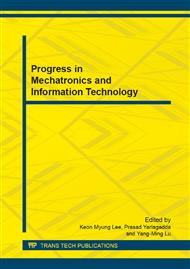[1]
L. Itti. Visual salience. Scholarpedia, 2(9): 3327, (2007).
Google Scholar
[2]
A. Toet. Computational versus psychophysical image saliency: A comparative evaluation study. IEEE trans. PAMI, (2011).
Google Scholar
[3]
L. Itti et al. Visual attention and target detection in cluttered natural scenes. Optical Engineering, (2001).
Google Scholar
[4]
http: /www. stanford. edu/~philkr.
Google Scholar
[5]
M. -M. Cheng, G. -X. Zhang et al. Global contrast based salient region detection. In CVPR, (2011).
Google Scholar
[6]
S. Goferman, L. Zelnik-Manor, and A. Tal. Context-aware saliency detection. In CVPR, (2010).
DOI: 10.1109/cvpr.2010.5539929
Google Scholar
[7]
L. Itti. Automatic foveation for video compression using a neurobiological model of visual attention. IEEE Trans. Image Process., (2004).
DOI: 10.1109/tip.2004.834657
Google Scholar
[8]
J. Wang, J. Sun, L. Quan, X. Tang, and H. Y Shum. Picture collage. CVPR, 1: 347-354, (2006).
Google Scholar
[9]
D. DeCarlo et al. Stylization and abstraction of photographs. ACM Trans. on Graphics, (2002).
Google Scholar
[10]
R. Rosenholtz, A. Dorai, and R. Freeman. Do predictions of visual perception aid design. ACM Transactions on Applied Perception (TAP), (2011).
DOI: 10.1145/1870076.1870080
Google Scholar
[11]
N. Parikh et al. Saliency-based image processing for retinal prostheses. J. Neural Eng. 7, (2010).
Google Scholar
[12]
J. Harel et al. Graph-based visual saliency. In NIPS, pages 545–552, 2006. 2, 6.
Google Scholar
[13]
C. Koch and S. Ullman. Shifts in selective visual attention: towards the underlying neural circuitry. Human neurobiology, 4(4): 219–227, 1985. 1, 2.
DOI: 10.1007/978-94-009-3833-5_5
Google Scholar
[14]
L. Itti, C. Koch, and E. Niebur. A model of saliency-based visual attention for rapid scene analysis. IEEE TPAMI, 20(11): 1254–1259, 1998. 2, 6.
DOI: 10.1109/34.730558
Google Scholar
[15]
T. Liu, J. Sun, N. Zheng, X. Tang et al. Learning to detect a salient object. In CVPR, (2007).
Google Scholar
[16]
R. Achanta et al. Frequency-tuned salient region detection. In IEEE CVPR, (2009).
Google Scholar
[17]
X. Hou and L. Zhang. Saliency detection: A spectral residual approach. In IEEE CVPR, (2007).
Google Scholar
[18]
N. Murray, M. Vanrell, X. Otazu, and C. Parraga. Saliency estimation using a non-parametric low-level vision model. In IEEE CVPR, pages 433–440, (2011).
DOI: 10.1109/cvpr.2011.5995506
Google Scholar
[19]
L. Itti and P. Baldi. Bayesian surprise attracts human attention. In NIPS, 2005. 1, 2.
Google Scholar
[20]
L. Duan, C. Wu, J. Miao, L. Qing, and Y. Fu. Visual saliency detection by spatially weighted dissimilarity. In CVPR, pages 473–480, 2011. 2.
DOI: 10.1109/cvpr.2011.5995676
Google Scholar
[21]
Y. Niu, Y. Geng, X. Li and F. Liu. Leveraging stereopsis for saliency analysis. In CVPR, (2012).
Google Scholar
[22]
F. Perazzi, P. Krähenbühl, Y. Pritch and A. Hornung. Saliency Filters: Contrast Based Filtering for Salient Region Detection. In CVPR, (2012).
DOI: 10.1109/cvpr.2012.6247743
Google Scholar
[23]
R. Achanta, A. Shaji, K. Smith et al. SLIC Superpixels. Technical report, 2010. 3.
Google Scholar
[24]
A. Criminisi et al. Geodesic image and video editing. ACM Trans. Graph., 29(5): 134, 2010. 3.
Google Scholar
[25]
Y. -F. Ma and H. Zhang. Contrast-based image attention analysis by using fuzzy growing. In ACM Multimedia, pages 374–381, 2003. 2, 3, 6.
Google Scholar
[26]
A. Adams, J. Baek, and M. A. Davis. Fast high-dimensional filtering using the permutohedral lattice. Comput. Graph. Forum, 29(2): 753–762, 2010. 3, 4, 5.
DOI: 10.1111/j.1467-8659.2009.01645.x
Google Scholar
[27]
T. Kadir and M. Brady. Saliency, scale and image description. International Journal of Computer Vision, 45(2): 83–105, 2001. 3.
Google Scholar
[28]
C. David. The basic composition skills. Digital camera. 2011. 3.
Google Scholar
[29]
X. -Y. Peng. Photographic composition elements and skills analyse. Social science discipline research. 2011. 6.
Google Scholar
[30]
J. Dolson et al. Upsampling range data in dynamic environments. In CVPR 2010. 5.
Google Scholar
[31]
D. Martin, C. Fowlkes, D. Tal, and J. Malik. A database of human segmented natural images and its application to evaluating segmentation algorithms and measuring ecological statistics. In Proc. 8th Int'l Conf. Computer Vision, volume 2, pages 416–423, July 2001. 5, 7.
DOI: 10.1109/iccv.2001.937655
Google Scholar


